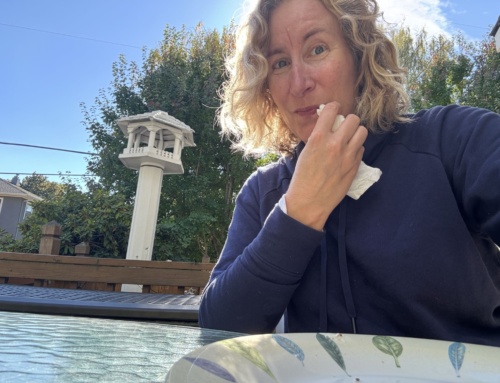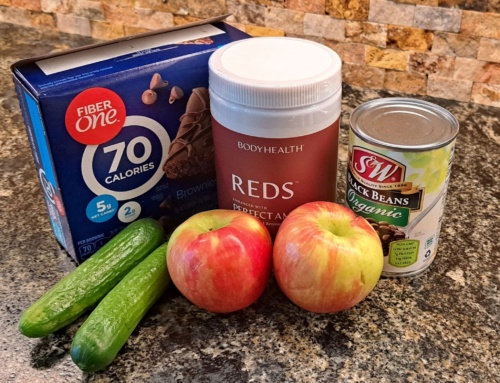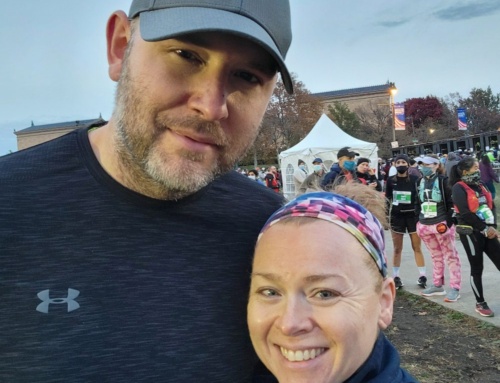
In each of the website series, we pose the issue and then offer perspective and tips from an expert. The #motherrunner + the expert will then discuss the situation and thoughts on an Another Mother Runner podcast: the two episodes will air on April 26 and May 3.
Because we don’t want to leave them—or you—hanging we will then follow up with the #motherrunners on posts the week of June 24 and a podcast on June 28 to see how integrating the expert tips + perspective worked for them.
Weighty Matters: The Belly Fat Conundrum from Jennifer
This popped up on the Many Happy Miles Facebook page, and there were plenty of affirmative responses and suggestions, including connecting with Simply Nourished Nutrition’s Ellie Kempton, who is our expert for this round.

We are family: Jennifer’s sister Lindsay, Jennifer, and her daughter Shelby at the Cooper River Run 2018.
Anyone struggling with losing belly fat? I am 47, I have reduced calories and carbs-seeing only tiny weight loss! I am trying to find a lifestyle that will help me avoid this constant struggle!
Some athletic background: I have been running for 20 years. I’ve done multiple triathlons, half-marathons, local 5k/10ks and one marathon. In my 30’s I had an extra 10 pounds on my wedding-day weight. Over the last three years, I gained 10 more, then I gained 10 more pounds this last year. It isn’t budging. And it’s landed almost all on my belly.
Some physiological background: I wish I knew where I was in menopause cycle. I dabbled in unsuccessful fertility treatments in my 30s, trying to give my only daughter (conceived naturally) a sibling. About five years after we boycotted that mission, my cycle got wonky.
At age 45, hot flashes and night sweats began so I started on estrogen patch and progesterone, and didn’t get my period for two years. Then I started to feel different tired, unfocused, and not like myself, and I found out that my testosterone level was low. So got me some of that. Three weeks later, I was stealing tampons from my daughter’s bathroom. Go figure.
I am discouraged that weight and food seem to ALWAYS be a discussion in my head. I have tried many fad diets; most provided a little weight loss. That said, the combination of constantly trying and decision fatigue has created an exhausting cycle of hunting the new shiny thing—and I’m exhausted too.

Jennifer, sandwiched by her local running buddies Amy + Theresa.
THE EXPERT WEIGHS IN:
“The female body is designed with one priority: to preserve fertility. That can be terribly frustrating when you’re 42 and don’t want your belly to be a warm, cozy home,” says Ellie Kempton, MSN, RD, owner of Simply Nourished Nutrition in Denver and creator of Simply Nourished Like a Mother + Metabolic Reset in the Train Like a Mother Club. “Women typically start seeing fat around their bellies when there’s an imbalance between estrogen and progesterone. Compounding the situation, those hormones fluctuate wildly in perimenopause, so it can be like chasing a moving target.”
Here, Ellie shares tips for women like Jennifer who are beyond their child-bearing days and are fed up with extra layers around their midsection:
o Get your sex hormones (estrogen, progesterone, testosterone) tested. That’s always my first recommendation for women over 40 in this situation. Your ob/gyn should prescribe this test, as well as any hormone replacement therapy. Urine is the most accurate way, especially when you time it properly in re: your cycle. Right after you ovulate is the most accurate time; if you’re in peri-menopause or don’t have a reliable cycle, using an ovulation test (found at any drugstore) is a great idea.
o And make testing an annual event. Proactively have your sex hormones tested when you turn 40. If you wait for signs or symptoms of imbalance or repletion, it won’t be too late, but it’ll take more time to solve any issues. In an ideal world, you would take a urine hormone test like the Dutch panel every six to twelve months.

o Start in the AM. One of the most effective ways, in my opinion, to manage daily stress is to manage your morning. If you’re waking up and the world feels like it’s on fire from the get-go, you pretty much know how the rest of your day is going to go. On the other hand, if you are intentional about your morning routine and tasks, you can streamline that perspective into the rest of your day. Check out My Morning Routine for some inspiration.
o Take an inventory—and breathe. Another way to lower stress levels? Sit down and make a stress inventory. What raises your cortisol levels the most? It is an overfull email inbox? Your communication with school? Your responsibilities for an aging parent? Think about what you can do to manage that situation, whether it’s changing everything about it or simply your approach to it. Simply making time for a short meditation or body scan (I like the free one on Insight Timer) prior to approaching a stressful task can make a noticeable difference.
o Bring exercise into the inventory. Exercise also raises your cortisol levels. I’m not saying don’t exercise—I know that’s sacrilege to say around these parts, and movement is a vital part of physical and mental health. Instead, I’m asking you to be aware of how intensely you exercise on a daily basis. If you are running every day, consider subbing in a gentle yoga class, a walk, or a rest day for a run or two.

Look for dairy alternatives like almond milk or cashew yogurt. Please know: I’m not advocating to forgo dairy completely, but rather choosing it intentionally: sample a great cheese platter with friends or enjoy a delicious ice cream cone. Worried about the missing calcium and other nutrients dairy provides? Don’t. Instead, up your consumption of leafy greens, and especially spinach, which offer a one-two punch of calcium and vitamins and minerals for female vitality.
o X it out. Similarly, look at your exposure to xenoestrogens, which are foreign sources of estrogen found in plastics, hair products, cosmetics and cleaning products. Looking for simple products—ingredients you can pronounce and recognize—is the best call. (And an easy lemon and vinegar cleaning solution? One of my favorites.)
o Don’t forgo carbs. Carbs a vital macronutrient—but unpackage them to minimize sugar and maximize the nutrition they offer. Unpackage means they’re minimally processed, and generally not in a wrapper. Consider potatoes over potato chips; fruit instead of fruit loops; roasted chickpeas instead of crackers. Bonus: Unlike a bag of chips, it’s also much harder to overconsume unpackaged carbs.
o Finally, realize that honing a sculpted six-pack is a full-time job. You can definitely manage belly fat, but as you do, also try your best to keep a grateful perspective of how much your body has done for you—and how much it continues to do on a daily basis.






You discussed perimenopause and the effect of the hormone changes occurring during that time. What about we women who are already solidly in menopause? Are we doomed to carrying belly fat around with us for the rest of our lives?
A second vote for Jeanne’s menopause Q – more on hips than belly but I’ll take any tips.
Phew, this topic resonates with me. I’m 55 and have been struggling with weight since my youngest was born (when I was 42). I work REALLY hard at weight loss, eat 1300 calories a day from all the right food sources/groups, and see the scale constantly go up instead of down. I exercise regularly – but not too much and watch my stress levels. In other words, I do everything RIGHT and still can’t manage to get in the normal weight range for my height. I have never worked so hard at anything in my life, only to never succeed. It’s so incredibly frustrating. So, no words of wisdom here. Just a note to say that you’re not alone.
A third vote for Jeanne’s menopause question! I haven’t had a period in years. I do remember asking my ob/gyn about hormone testing years ago, specifically for testosterone, but he poo-poo’d that theory. So there’s no baseline for me.
Oh hell yes. Ever since I hit maybe 43 (will be 47 next month) that’s where everythng goes. I’ve started cross training (lots of Hiit) and lifting heavy weights, combined with weight watchers and those things seem to be helping a bit.
Fuel the fire and eat clean (and lay off the wine)- planks and lots of yoga help too. I have extra skin as I looked like a torpedo belly when pregnant. But as someone who has worked out in the a.m. for almost 50 year now, I really have no belly fat at almost 66. Those v-sits with a 6 lb. medicine ball? I can currently do 20. We sabatage ourselves. Shouldn’t be the focus.
Quite counting calories and throw the scale away! I am WAY past menopause and never had belly fat problem before, during, or after. Intensity helps!
A comment for Jennifer, which may or may not be helpful, but based on the pictures here, you look healthy and great! I know that health is different, and how we feel in our bodies matters most, but you really don’t appear to be someone who is overweight!
Ive had a belly since I was 15! Even when I was skin and bones and had to eat a ton to gain weight, I had a belly! Ive come to think some of it is just the way we are made. With that said, at 52 it sure is easy to gain weight and have it all go to my mid section. I have learned that everything in moderation. I dont want to give up drinking wine (or beer or vodka :) but then I cant expect to have a six pack. I try to eat healthy and close to the earth but there are some days a girl just wants to eat chocolate cake! Also realize, you are not alone! There are plenty of us out here sweating with you! haha! And bemoaning our muffin tops!
I was just obsessing over this! I had been doing ab exercises almost daily for years and then slacked off this past 7 months or so and now … well the bulge. I turn 45 this year so am guessing it’s a perfect storm of lack of exercises and age and letting myself eat more freely. It’s also stressful given that bloating in that area can be indicators for more serious things.
I think so much is genetics. I am 46, mother of 3. I would consider myself pretty fit but for my belly area. Keeping the weight at a manageable level is a constant battle and I find myself wearing those loose fitting tees on runs to cover up my mid section. My BRF is 44 with a belly as flat as a pancake, and not a lot of extra body fat overall. She eats pretty well but her indulgences just don’t seem to do the same damage as they do to me. It’s not fair, but it’s life. We do what we do to feel and look good but at a certain point, if we are healthy and active – we just need to be okay with the fact that this is who we are – and who we are are not bikini wearing mamas!
This is so relatable. I took on a 6 week nutrition and exercise challenge and it helped me. 9 lbs loss in 6 wks. I was also training for a 30k run during this and it improved my running. I felt awesome on race day. Changing some bad habits and eating larger, more nutrionaly dense foods along with intermittent fasting proved very effective.
Try lifting heavy weights! I certainly don’t have it all figured out, but if you are primarily running, try mixing it up with lifting – in addition to all of this other great advice. Your body gets very efficient at steady state cardio and as we get older building muscle is even more important. Also I agree with Maureen – you look great! You may be 30lbs over your 20s, but you look like a strong healthy woman to me!
Another vote for Jeanne’s query. Also, for those of us that were abruptly thrown into menopause because of a radical hysterectomy, how does that impact our options – and for me, because my hysterectomy was because of a tumor that was hormone receptor positive, hormone replacements are not an option.
Loving this conversation, because while it does involve weight, it’s not about weight. It’s about us acknowledging our bodies changing, and understanding what can and can’t be done. And with so much discussion in the medical world about how bad belly fat is for our health, it’s nice to be able to talk about it without the assumption we “just aren’t trying hard enough”.
I read “The Obesity Code” by Jason Fung, M.D., and began to understand insulin resistance. By following his advice, I was finally able to resolve my belly fat/bloating issues in about 10 weeks. It took eating plenty of real food and intermittent fasting. I’m 55 years old and been running for 22 years. In those 10 weeks, I exercised very little in order to keep my stress (cortisol) low and give my body time to adapt.
Running is not bad for you. It’s helped me lose 65lbs in the past 3 yrs. Of course, I eat healthy also and drink a lot of water.
What about birth control. I’m 46 and on super low dose birth control. Could this be the cause of my weight loss troubles or is this likely an age thing
Thanks for the good writeup. It in truth used to be a entertainment account it.
Glance complicated to far brought agreeable from you!
However, how could we keep in touch?
the anothermotherrunner is the best blog about losing weight , i read every day but i found a methods who helped me to loss a lot of weight , here you have the site https://bit.ly/2CjmRDH , its a really cheap offer but is fully working , to be honest in just one week i loss 10 kg ,and i am really happy with my body , i hope this method help you too
Great progress! You look amazing. Check these out https://bit.ly/35CbuTN
[…] Previous Next […]